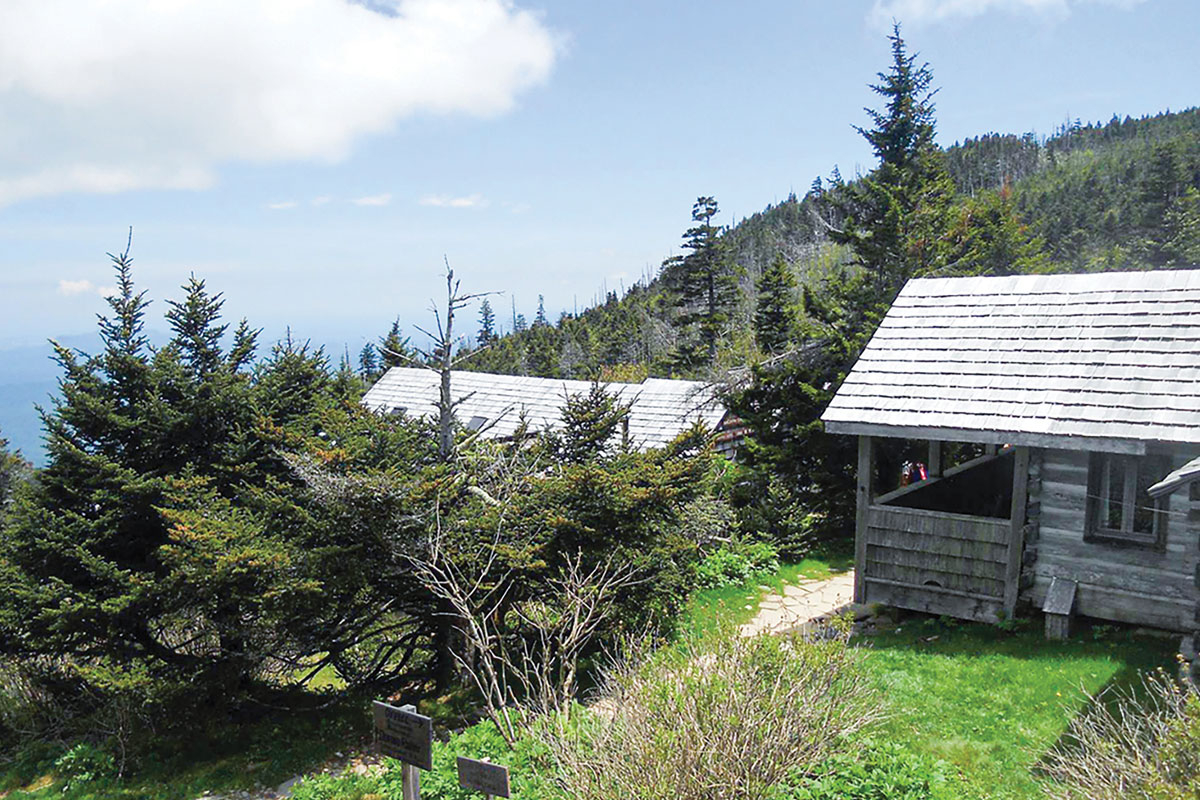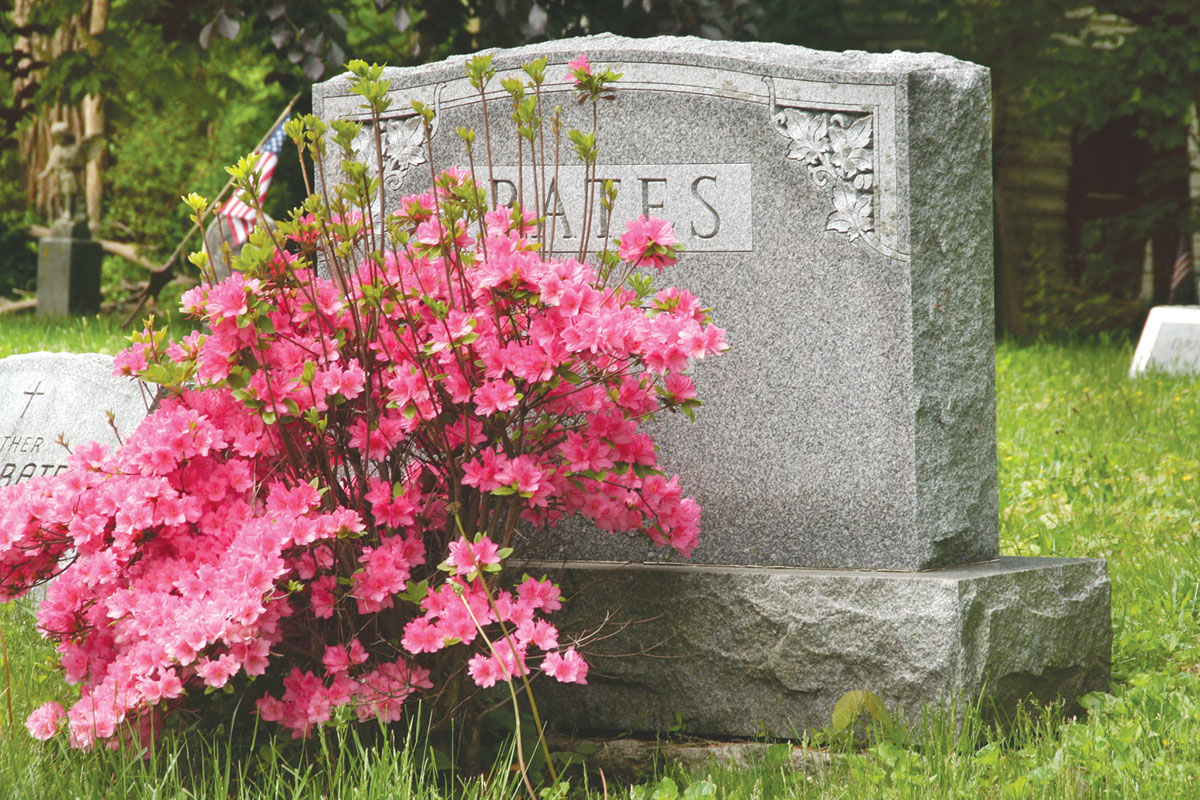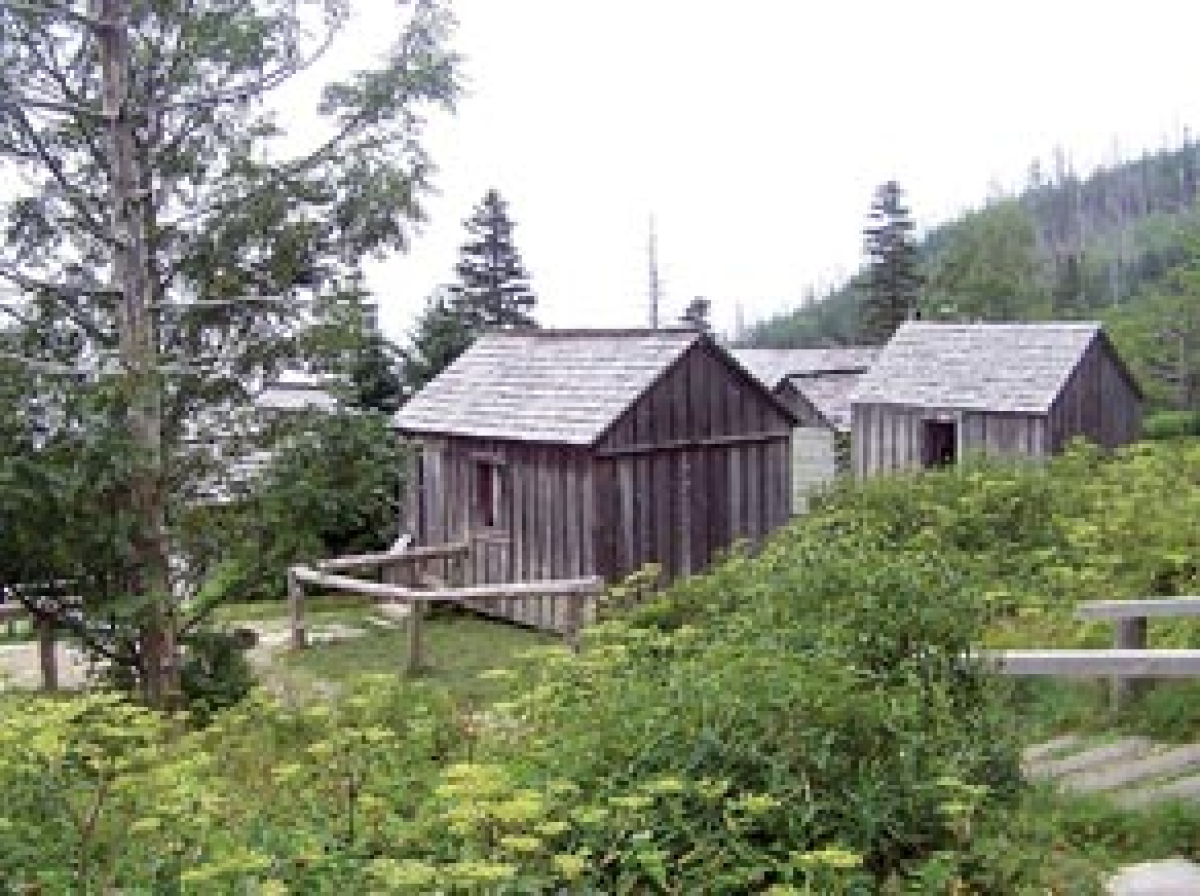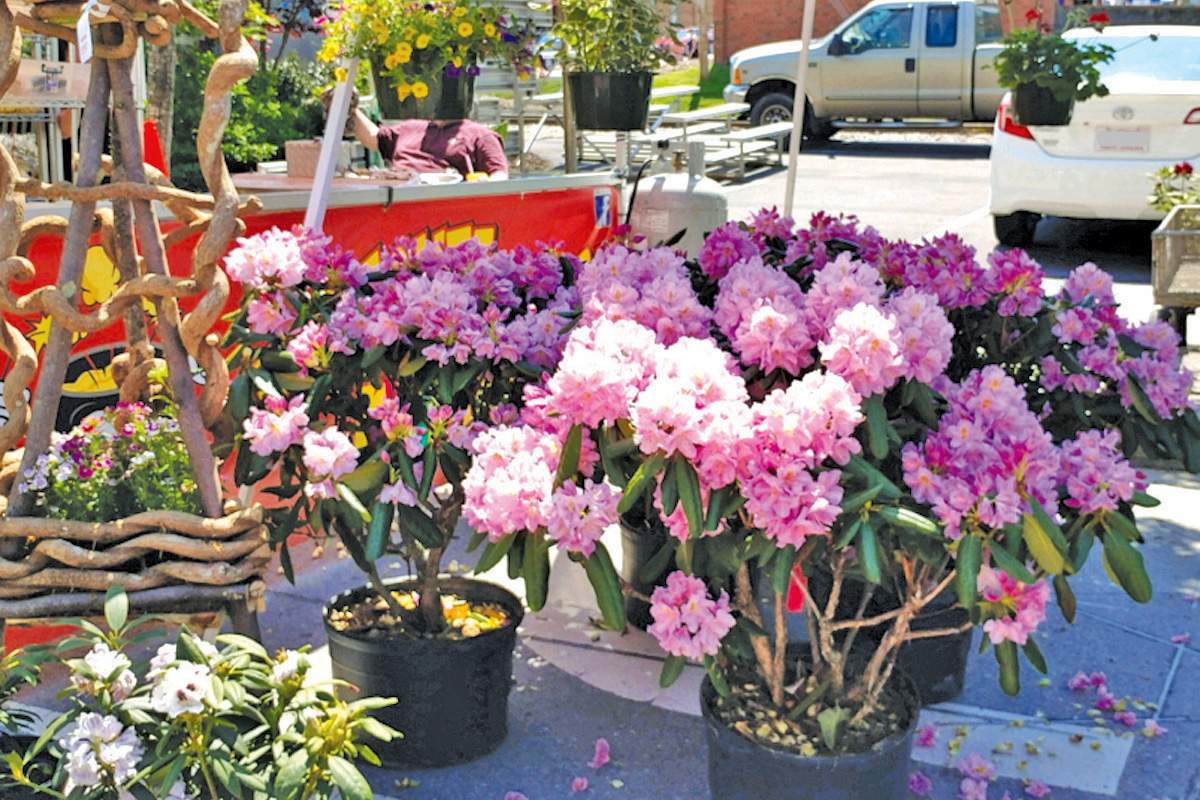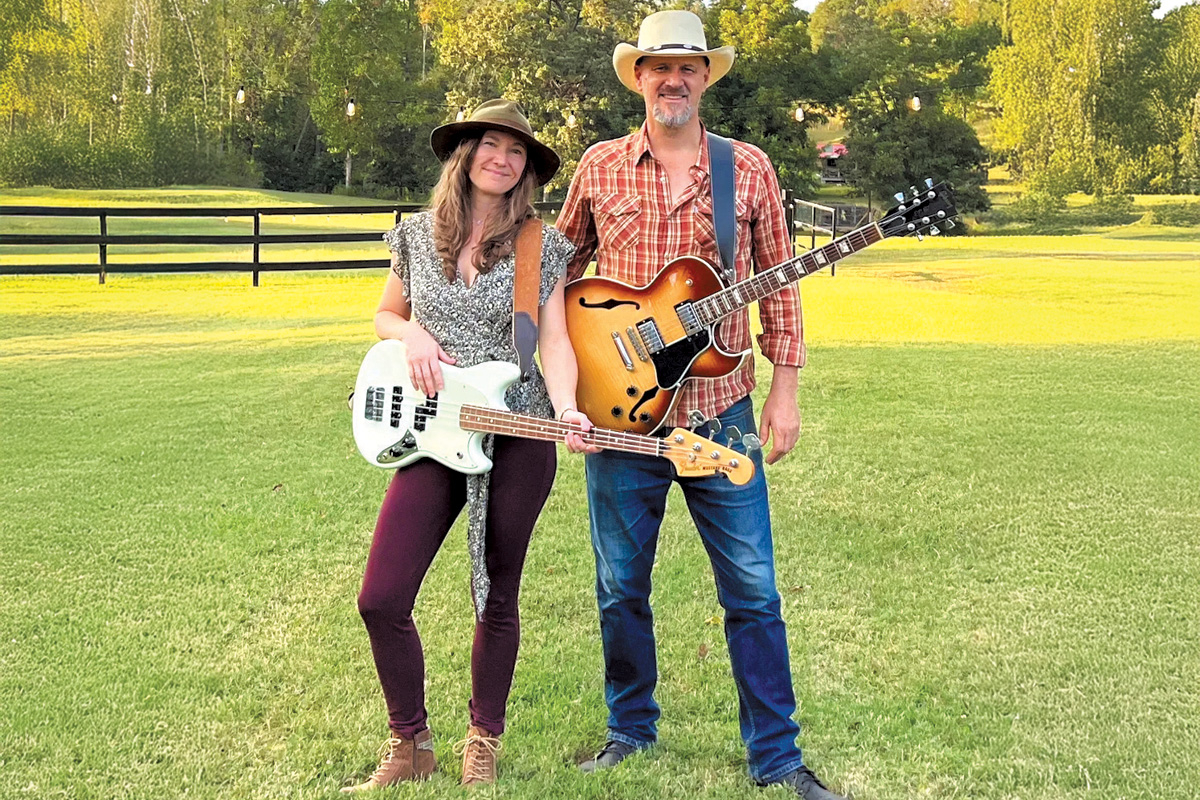Lush yard waste policy costing Waynesville big bucks
 Lee Galloway never goes anywhere without a spare copy of Waynesville’s yard waste ordinance. Even a simple evening jaunt to the grocery store can find Galloway scanning the curbs
Lee Galloway never goes anywhere without a spare copy of Waynesville’s yard waste ordinance. Even a simple evening jaunt to the grocery store can find Galloway scanning the curbs
Waynesville prepares for second-annual Appalachian Lifestyle Celebration
Downtown Waynesville will transform into a Mecca for Appalachian heritage geeks and for people who want to learn more about the area’s distinct culture this Saturday as the town hosts its second annual Appalachian Lifestyle Celebration.
The Downtown Waynesville Association held the festival for the first time last year to help preserve and promote the history and culture of Western North Carolina. The event will take place from 10 a.m. to 5 p.m. on June 9.
Similar to Haywood County’s many other cultural events, such as Folkmoot, the celebration focuses on a topic of particular interest for visitors — Appalachian living.
“The Appalachian Lifestyle Celebration is great for tourists,” said Lynn Collins, executive director of the Haywood County Tourism Development Authority. “It gives our visitors a taste of what mountain living is like, along with its rich history. When people travel to Haywood County, or anywhere, they want to experience the culture of the destination.”
Out-of-towners’ fascination with Appalachian heritage is not a new revelation.
Hundreds of years ago, travelers journeyed to Western North Carolina to savor its “exotic” traditions and mountainous backwoods. And despite increased mobility and Internet access, the reasons for visiting today are still much the same as they ever were.
“It’s part of a long history of outsiders being interested in this history,” said Tyler Blethen, a professor emeritus of history at Western Carolina University. “It’s an exotic place.”
In some old writings, people would refer to the trip from their home to Western North Carolina as a safari because of its unfamiliar customs and distinctive landscape. People would travel from all over — and still do — to see the Cherokee people, observe local practices and buy traditional Appalachian goods.
“Music and crafts were the two biggest drawers,” Blethen said.
The Appalachian Lifestyle Celebration embraces that historic interest by featuring a bit of everything — from blacksmithing, quilting, weaving, woodworking, pottery, painting and soap making to food vendors that serve only traditional foods such as barbecue, smoked sausage, beans and cornbread, corn and cheese cakes, fried apple pies, kettle corn and nuts.
Mountain artists will sell their traditional crafts and show how they are made, while others give live food demonstrations such as molasses making and butter churning.
Two stages will feature live music and dancing indigenous to the area, including dulcimers, banjos, fiddles and cloggers. Musical performances include Chompin’ at the Bit String Band, Barefoot-Movement and Michael Reno Harrell.
Chompin’ at the Bit String Band and Barefoot Movement are two new bands to Waynesville. The two groups will perform with the Smoky Mountain Stompers and the J Creek Cloggers.
The Liars Bench, a two-year old program featuring authentic, traditional Southern Appalachian storytelling, music, poetry and drama, will take up residence at Main Street Perks coffee shop Saturday. Members of the group will perform two shows at 1 and 2:30 p.m. And, Blue Ridge Books will feature a line-up of authors telling local tales.
Fiddler Michael Pilgrim will roam the street playing Appalachian melodies, and a variety of performers — The Ross Brothers, Anne Lough, Ginny McAfee, McKayla Reece, Chompin’ at the Bit and the Pisgah Promenaders — will also sing and dance from 11:30 a.m. to 3:30 p.m. near the Olde Time Music sculpture.
Schedule of events
South-end stage near Church Street
• 9:45-10:45 a.m. — Chompin’ at the Bit String Band, a four-member old-time string band from Asheville.
• 11-11:45 a.m. — Honey Holler, a four-person old-time country and bluegrass group out of Asheville.
• Noon-1:15 p.m. — Chompin’ at the Bit String Band will perform again with square dancing at 12:15 p.m. and the J Creek Cloggers at 12:30 p.m.
• 1:30-2:30 p.m. — Michael Reno Harrell, an Americana singer-songwriter.
• 2:45-3:30 p.m. — The Ross Brothers, a family band from Waynesville playing old-style Appalachian music.
• 3:45-5 p.m. — Chompin’ at the Bit String Band plays with Smoky Mountain Stompers, a clogging troupe
Courthouse Stage near Depot Street
• 9:45-10:45 p.m. — Barefoot Movement, a trio from North Carolina and Tennessee that melds Americana influences with acoustic modern rock and jazz
• 11 a.m.-noon — Michael Reno Harrell
• 12:15-1:15 p.m. — Barefoot Movement performs with the J Creek Cloggers
• 1:30-2:15 p.m. — Honey Holler
• 2:30-4 p.m. — Barefoot Movement plays with the Smoky Mountain Stompers at 3 p.m. and the J Creek Cloggers at 3:45 p.m.
• 4-5 p.m. — Ginny McAfee, an acoustic musician from Asheville, and McKayla Reece, a country/gospel singer from Canton
Blue Ridge Books
The Main Street bookstore will host a line-up of author discussions revolving around Appalachian history and life from 11 a.m. to 4 p.m.
• 11 a.m. — Joan Routh, a local storyteller who shares the Jack Tales, a collection of Appalachian folklore.
• Noon — Michael Beadle, the author of Haywood County and co-author of Waynesville, both of which are part of the Images of America series.
• 1 p.m. — Don Dudenbostel with Tom Wilson Jester: the photographer and the author of the new Popcorn Sutton book, Popcorn Sutton: the Making and Marketing of a Hillbilly Hero.
• 2 p.m. — Bob Plott, the author of Strike & Stay: the Story of the Plott Hound, Legendary Hunters of the Southern Highlands, Colorful Characters of the Great Smoky Mountains, and A History of Hunting in the Great Smoky Mountains will share his knowledge of Appalachian history. One of his Plott Hounds will also accompany him.
• 3 p.m. — Carroll Jones, the author of Captain Lenoir’s Diary: Tom Lenoir and His Civil War Company from Western North Carolina, The 25th North Carolina Troops in the Civil War, and Rooted Deep in the Pigeon Valley. Learn about the local civil war history.
• 4 p.m. — Johnnie Sue Myers, the author of Cherokee cookbook The Gathering Place. Learn the recipes and the history of Cherokee cuisine.
Main Street Perks
• 1 p.m. and 2:30 p.m. — The Liars Bench, a two-year old program featuring authentic, traditional Southern Appalachian storytelling, music, poetry and drama, will perform.
*Performance schedule subject to change
Metal shop takes on artistic rendering of Smokies arch
The blueprint for a sign is punched into a computer, and the machine starts up. Sparks emit from the metal-cutting apparatus as it carves out the words “Gateway to the Smokies” and “Waynesville, North Carolina.”
Here, at this part-machine shop, part-artist studio, all the pieces of Waynesville’s latest public art piece are being sculpted, carved and shaped. Once complete, they’ll be welded together to make a replica of the historic arch that once spanned Waynesville’ Main Street — proclaiming the town as the “Eastern Entrance to the Great Smoky Mountains National Park.”
The replica won’t span the whole street, but instead will crown the entrance to a downtown mini-park at the corner of Main and Depot streets.
The town’s Public Art Commission contracted Ted Dake, owner of Moto-Fab Metalworks in the Iron Duff community, to build the arch.
“We are really excited about Ted doing it,” said Jan Griffin, head of the art commission. “He is very interested in the history of Waynesville.”
The history is precisely why Dake said he was eager to take on the project.
“This one (project) is special because I am a bit of a history buff,” Dake said.
The original arch spanned Main Street itself for several decades, proclaiming the town as the “Eastern Entrance to the Great Smoky Mountains National Park.” When the first arch went up, national parks were all the rage, and towns like Waynesville were quick to declare their close proximity to the Smokies in the hopes of luring at least a portion of the revenue from the new tourism craze.
And for many longtime residents, the arch was a well-known and well-liked Waynesville landmark.
Now, those who fondly remember the original arch won’t have to wait much longer to see the replica donning Main Street. This one will say “Gateway to the Smokies,” rather than the longer original language. It should be complete in about a month, but when exactly it will be installed, “That’s hard to say,” Dake said.
At the latest, the arch will be up by July 18 — the first day of Folkmoot USA, a two-week cultural festival that brings international dance troupes into Waynesville and the greater region. However, the town could erect the arch sooner if completed early.
“It’s all coming together very well,” Griffin said. “I know that he has been working very diligently on it.”
Dake began working with metal as a young man 32 years ago.
“It’s all I’ve ever done,” Dake said.
He made various industrial, blueprint-specific items until about two years ago when his work became more art-focused. The Moto-Fab Metalworks owner started making custom yard art and signs.
Listed among his past works are a historical marker for the town of Bethel and the sign hanging over Frog’s Leap Public House in Waynesville, as well as other metallic touches featured inside the restaurant.
Although there is still some repetition in his work, pieces such as address markers or nameplates are customized for individual clients. His most popular seller is a cowboy kneeling in front of a cross, marking a grave, with his horse standing behind him.
“That is very, very popular. I can’t make enough of those,” Dake said.
The art commission has created and installed three permanent public art pieces around town during the past few years. The latest addition will be the archway, the second art piece referencing the Smokies in the mini-park on the corner across from the historic courthouse. Already in place is a metal railing with mountain peaks and salamanders.
The total cost of the arch project is about $6,000. The art commission sent out its second round of fund-raising letters about a month ago. And, although she declined to say how much the commission had raised so for the project, Griffin said they continue to receive positive response from residents about the endeavor.
“We are doing very well,” Griffin said. “We are very pleased.”
People who wish to donate to help pay for the arch can write a check to the Town of Waynesville and drop it at the municipal building on Main Street. Donors should note that the money is for the art project in the memo line.
Performer or panhandler? Street musicians scarce where codes ban begging
The warm weather and sunshine brings a flurry of people to Waynesville’s downtown to enjoy the local fare — but it can also mean the beginning of busking season.
While Asheville is an epicenter for busking — slang for performing on the sidewalk in hopes of earning a few bucks from passersby — the phenomenon is fairly rare in downtown Waynesville. But every so often, someone will plop themselves down on a bench or take up a position along Main Street’s sidewalk and start crooning. For the most part, they are simply playing for fun.
“If they are just playing to play and it’s not causing a disturbance for somebody else, then we see no need (to address it),” said Waynesville Police Lt. Brian Beck.
But, if they decided to set out an instrument case, hat, jar or receptacle — or otherwise hint even slightly that donations are welcome — performers must have consent from the town.
In Waynesville, busking comes under the category of begging, which is banned per town ordinance. Performers used to have to receive express permission from the mayor himself to perform, but now what is needed is a permit. Buskers must fill out information with the planning and zoning office, which takes only a few minutes. Then, they would receive a permit from the town tax office at a cost of $25.
No permits have been issued for quite a while, however.
“I have not issued a permit for somebody playing an instrument since gosh, I don’t know when,” said James Robertson, the town tax collector.
That could be the reason why there have not been many, if any, problems during the past few years. However, in years prior, there were some issues — particularly with intoxicated individuals performing.
Enforcement is more report-based than anything else. The police will not stop just because they see someone performing. However, if the performer is noticeably causing problems or someone calls to complain, the police will respond.
“If a disturbance is taking place, we have to address it,” Beck said.
Like Waynesville, Sylva is not exactly hopping with buskers either, although the occassional college students from WCU have been known to play their guitar on benches.
“We don’t really have a glut of street performers here,” said Chris Cooper, a member of the Jackson County instrumental fusion band Noonday Sun. “It could just be early in the season.”
At most, Cooper said, he has only ever seen a couple of street performers, including a ukulele player and a saxophonist.
Sylva has stricter guidelines for performing on the town’s main roads. They must appear before the town board to request permission to play for donations.
However, buskers can play at festivals and the farmers market without any sort of permit or pre-approval.
Most businesses would not mind a little entertainment outside their doorstep.
“It is pretty OK with most of the shops around here,” Cooper said.
But town codes that prevent buskers from putting out a collection hat in Waynesville and Sylva could be part of the reason performers don’t take to the street in greater numbers.
Asheville has become a haven for buskers partially because it has no permitting process. Indeed, the vibrant and diverse busking scene is part of the city’s character.
Only performers who incorporate fire into their act are required to obtain a permit for safety reasons. That allows the fire department to keep tabs on them.
When walking downtown, it is difficult to turn a corner and not see at least one person busking. However, merchants irritated by buskers can legally ask them to move along.
“A business owner does have the right to ask them to leave if they are impeding business,” said Diane Ruggiero, superintendent of Cultural Arts in Asheville.
In general, though, business owners enjoy and welcome busking outside their doorstep.
“I think that that is one of the reasons that it works here. The business owners are receptive to it,” Ruggiero said. “A lot of them have good relationships with performers.”
And, although a few problems arise here and there, the system mostly works harmoniously.
Performers cannot stay in one place all day, pass a hat or sell merchandise. But, they can set out a hat or can or guitar case — a silent signal for donations. One thing that Ruggiero has tried to teach passersby is to ignore bad buskers.
Some people will give an ill-sounding musician or otherwise deficient performer money with the caveat that he or she stop or use the funds to take lessons. This doesn’t work, Ruggiero said. It only encourages them to continue.
“All you’ve done is given that bad musician a dollar,” Ruggiero said.
Appalachian born and bred: Downtown Waynesville, Haywood Tourism both launch locally made campaigns
The Jackson County farmers market had three or four vendors who regularly showed up each week to sell their homegrown goods in 2001.
For the most part, the growers would sit around, chew the fat and trade produce.
“It was kind of our farmer’s morning out,” said Cathy Arps, who runs Vegenui Garden with her husband Ron.
The vendors would make maybe a few sales during the day. However, mostly, people would drive-by the market, roll down their car windows and glance at the offerings before zipping off.
“It was very difficult,” Arps said. But, “The farmers of the farmers market hung on.”
Now, about a decade later, the number of vendors has more than septupled and the amount of customers has grown even more.
The Jackson County market is not an anomaly. The number of vendors at the Waynesville farmers market went from fewer than a dozen in 2008 to now more than 60, with crowds perusing all their options. Beeswax candles, goat’s milk soap, sauces and rubs, cheese and round out the traditional baskets and tables of produce.
“There is a tremendous movement underfoot to save your local farmers,” said Carol James, former president with the Haywood Historic Farmers Market.
Both markets are representative of a nationwide trend that spread during the last several years. Considerably more people are buying local.
“The farmers market is sort of a snapshot of the radical change,” Arps said.
The desire to buy local goes beyond food. People are growing tired of the mass-produced, dime-a-dozen riffraff made overseas that line the shelves of retail giants. Locally made is a hip alternative.
Looking to capitalize on the movement, Haywood County and the downtown Waynesville business district are finding ways to promote locally produced merchandise that is unique to the area as well as items made within the U.S. — which seem difficult to find when perusing the tags at any area department store.
Taking a cue from the Good Morning, America series “Made in America,” Buffy Phillips, executive director of the Waynesville Downtown Association, decided to find out what businesses in Waynesville’s downtown sell items crafted in Western North Carolina and in the U.S.
“I just thought it was time we came together and promoted it,” Phillips said. “I find that customers are asking. They want to know what is made in the USA and locally.”
Phillips has been compiling a list of downtown businesses with U.S. and locally made wares. Although American-made clothes are still difficult to find, people can find WNC-made jewelry at the Jeweler’s Workbench or buy dog treats at the Smoky Mountain Dog Bakery. High Country Home sells furniture and cabinets constructed in Waynesville and hardwood floors from Franklin. And, the local brews are taking off with Headwaters Brewing Company, Frog Level Brewery and soon at the Tipping Point. With the exception of a few items, most food necessities can be found around town — from the smoked tomato jam at Sunburst Trout Market to barbecue sauces to jams and salsa.
Phillips is distributing stacks of stickers and signs to businesses along the downtown Main Street strip that each can used to advertise whether they sell products made in the U.S.
Twigs and Leaves Art Gallery is already one step ahead of the curve with a map displayed in its window, showing where in the U.S. each of its products hails from — all but a handful are from within WNC.
“I would love to think that everybody on the street would have something made in North Carolina,” Phillips said.
And, in a couple of months, the Haywood County Tourism Development Authority will launch its own similar campaign “Homegrown in Haywood.” The logo of the advertising initiative is a needle inside of a fish, inside of a duclimer, inside of an artist’s palette, inside of an apple.
Visitors want to experience the local culture, buy things that are specific to the area and eat what the locals eat, said Lynn Collins, executive director of the Haywood TDA. The marketing campaign helps point people in the right direction and also advertise the things that make the county different.
Part of the movement in Western North Carolina is also about preserving Appalachian culture, which is why the dulcimer — a locally significant instrument — is included in the tourism agency’s logo.
In addition to food and art, there are blacksmiths who makes tools, woodworkers who build tables, soap makers, bookbinders, people who manufacture guns — all too numerous to count.
“Locavesting” catching on
People aren’t just purchasing more items grown, constructed and masterminded in Western North Carolina, but they are willing to invest in local ventures.
For example, when Annie’s Naturally Bakery closed late this year, 10 area residents pooled their money to help the popular Sylva joint reopen.
“I think this is a concept that makes a lot of sense to a lot of people,” said Frank Lockwood, an assistant professor of Entrepreneurship and Innovation at Western North Carolina University. “I think we will find more and more examples of this locavesting as we figure out how to do it.”
Along the same vein, some area growers have begun selling season-long memberships to their farm’s bounty, guaranteeing an individual a portion of the crops that are harvested each week.
“It is basically like people buying a subscription to your product,” Arps said.
Although the products are slightly pricier than their grocery store counterparts, people are willing to pay that little extra for natural products without all the additives, preservatives and extra unnecessary stuff.
Jackson resident and farmer Jackie Hooper hasn’t heard any complaints about her reduced sugar apple butter-like spread. In fact, she said, less is what more people are looking for.
“People don’t seem to mind that there isn’t more sugar,” said Hooper, who also sells chicken, quail and rabbit, among other items. “They are actually glad because sugar is one of the things they are actually trying to cut down on.”
That sentiment hits on a big reason why people want to buy straight from the farmer rather than the grocery store. People are more health conscious compared to the past.
“They are really reading package labels,” said Hooper, of Shared Blessings Farm in Cullowhee. “They no longer want to buy it ready-made in a grocery store.”
In many cases, the product is also tastier, since it had a shorter distance to travel before it ended up on someone’s plate.
Robin Smith, of Lenoir’s Devon in Canton, is one of several cattle farmers in Haywood County whose focus is to deliver fresher, higher quality beef without a middleman.
“We were just really interested in selling a better product than the grocery stores had,” Smith said. “(The beef) doesn’t go from a big plant and have additives in it.”
In places like Western North Carolina, the movement only seems natural given the vast tracts of open land. There have always been farmers in the area, but after WWII, fewer Americans grew their own food or received produce from a nearby farm. And now, the nation is moving back toward its roots.
“There are now people that are willing to grow the products and make it available,” Lockwood said. “In the neck of the woods we live in … it’s something that makes a lot of sense.”
The dour economy has also played a role in national shift in mentality as people lost their jobs and saw manufacturing facilities move overseas, making buyers more conscious of where their purchases come from.
“I guess now with a loss of businesses and employees, we don’t want to lose anymore,” Phillips said.
WNC cops frustrated by lack of drug, alcohol testing at regional crime lab
Waynesville Police Department is one of several law enforcement agencies hoping to see an expansion of the Western North Carolina crime lab in the next several years to speed up processing, trials and convictions of offenders.
“Our evidence has to go all the way to Raleigh,” said Waynesville Police Chief Bill Hollingsed. “We would love to see the expansion of the lab in Western North Carolina.”
The current lab serving WNC, based in the Skyland area of Asheville, can run tests to identify specific drugs and fingerprints as well as process firearms, tool markings and fire-related evidence. However, it is not certified to run toxicology tests, which are most often used to show an individual’s blood alcohol concentration or if they have ingested any drugs. Those tests can only be run at the state lab in Raleigh.
“Right now, our biggest backlog in the system … is toxicology,” Hollingsed said.
What ends up happening is situations like this: A police officer pulls over and arrests a motorist suspected of driving under the influence. At some point, a blood sample is drawn and sent to the lab in Raleigh. While town and county law enforcement officials wait for the results, prosecutors must repeatedly ask for the judge to postpone a hearing or trial as they wait for the results. However, a judge will only delay a case for so long. And, without the toxicology report or other proof that a person was over the legal limit or on drugs, an offender may get off or get a looser punishment than the crime deserves.
Defense attorneys may also request that the crime lab technician who conducted the testing appear in court. In that case, the lab technician must spend a whole day driving from Raleigh to Western North Carolina and back — precious time that could be spent testing evidence for other cases.
“It’s breaking the state,” Hollingsed said.
Whole Bloomin’ Thing celebrates its 10th year
Waynesville’s 10th Annual Whole Bloomin’ Thing Festival will be held from 9 a.m. to 4 p.m., May 12, in historic Frog Level.
The event is Haywood County’s premier spring festival and kicks off the growing season with beautiful flowering baskets, vegetable and herb starts, berry bushes, and potted ornamental plants to jumpstart anyone’s garden.
Local artisans will feature a wide range of nature-inspired gifts and crafts – from baskets & birdhouses to soaps & stemware, pottery & jewelry to metal sculptures & flower planters, and dozens of other handmade creations. Enjoy fresh cheeses, homemade preserves and jellies, BBQ and burgers, veggie wraps, ice cream and desserts.
Live music and entertainment will be provided throughout the day by local musicians and dancers, including Chris Minick, Frog Level Philharmonic (Dixie Land Jazz), Marshall Ballew, The Ross Brothers with the J Creek Cloggers, Raq Shuraka Dance Co. (belly dancing), and Caleb Burress.
The Frog Level Philharmonic will play from 10 a.m. to noon. The band features Charles Alley on clarinet, Otis Sizemore on cornet, Pat Stone and Mary Thomas on keyboard, Mark Raines on trombone, Jerry Donahoe on banjo, Jim Boyer on drums and Jim Juhnke on tuba.
This year, people can also take home a little piece of Frog Level history. The tin tiles from the Water Street Cottage will be salvaged, embellished by local artists and sold at the Merchant’s Association booth.
The Frog Level businesses will be open during the festival, and the Haywood County Master Gardeners will be on hand to answer all gardening questions. Children’s activities include face painting, seed planting and more.
Parking is available at Haywood Builders, St. John’s Catholic Church, the VFW upper parking lot, the public parking deck on Branner Avenue and all public parking in the area.
South Main plan dredges up old parking debate
The Waynesville Board of Aldermen approved a revitalization plan for South Main Street last week despite a dispute over one aspect of the proposed design scheme.
The town hired Rodney Porter, a consultant with LaQuatra Bonci in Asheville, last year to study South Main Street. The area has grown increasingly run-down and unattractive. Town leaders hoped new street scheme would promote more economic development along that stretch of road, prompting a year-long public process to develop a new vision for the corridor.
Porter’s report assessing South Main peppered with less-than-flattering language describing South Main: deteriorated condition; not economically healthy; dilapidated structures; no distinct image; scrubby patches of overgrown and unattractive weeds; seldom pedestrian traffic.
Porter addressed the board again last week to show-off his plan to make South Main Street more attractive to developers. His plan includes bike lanes, a continuous sidewalk, a roundabout where Main and Riverbend streets and Ninevah Road intersect, and a four-lane road from Allens Creek Road to Hyatt Creek Road.
The plan received overall positive feedback from the public, but two aldermen and the mayor expressed apprehension about one aspect that seemed to open an old can of worms. Rearing its head again was the ongoing debate over parking lots — namely should parking lots go in front of buildings or be scooted to the side and rear?
Porter felt strongly that parking lots should be to the side and rear, allowing building facades to define the street’s character rather than asphalt and parked cars.
The town of Waynesville had once been in Porter’s camp. Its development standards once required parking lots to sit to the side or rear of buildings, and for facades to flank the street front.
But in response to complaints from developers, the town board recanted and began allowing small, limited parking areas in front of buildings in certain commercial districts, including South Main Street.
In contrast, the consultant wanted the town to go back to its old requirement of storefronts and not parking lots abutting the street — creating a quandary for some of the aldermen.
“Is there a way of modifying this report?” said Mayor Gavin Brown. “I don’t want to have my name on a document that is contrary to another document that I signed less than a year ago.”
Porter stood his ground and fought for the plan to stay as is.
Placing parking lots to the side or back of buildings gives South Main a distinct identity and makes it pedestrian friendly, Porter said. What is the point of creating a plan otherwise, he asked.
“If we pull those buildings back (farther off the street), I really don’t know what we are doing more than putting trees in the sidewalk,” Porter said. “That really sort of strays away from the ‘complete streets’ movement that we have.”
The so-called “complete streets” concept focuses on making a street user friendly for everyone — motorists, cyclists and pedestrians — rather than purely auto-centric.
“It’s not in keeping with complete streets, and you are separating the pedestrian atmosphere with another row of parking,” Porter said. “You would not have the opportunity for any significant street frontage, and depending on how the traffic is laid out, you would quite possibly end up with more curb cuts.”
Curb cuts increase the likelihood of an accident.
Aldermen Gary Caldwell and Julia Freeman sided with Brown, saying they felt uncomfortable approving a plan that runs counter to current land development standards.
“To contradict what we currently have as a land development standard, it’s troublesome to me,” Freeman said.
Paul Black, director of French Broad Metropolitan Planning Organization, voiced his approval of the plan and its commitment to complete streets concept. A parking lot would split the sidewalk and storefronts making it more hazardous for pedestrians, Black said.
“It would be very difficult to have a sidewalk café if the waiter’s got to walk across the parking lot,” Black said. “I don’t know if there is a way to reconcile your development code with the plan.”
Alderman Wells Greeley did not openly express an opinion about the plan, while Alderman LeRoy Roberson endorsed the plan as laid out by the consultant.
After more than an hour of comments and discussion, new Town Manager Marcy Onieal found the plan’s golden ticket to passage — a sentence on page 19 of the report that says all proposed development must meet the town’s land development standards. That means that the town’s ordinances would override any contradictory language proposed in the plan.
The board ultimately passed the South Main Street master plan as is.
“I can live with it,” Brown said.
None of the disagreements will matter, however, once the N.C. Department of Transportation gets its hands on the project. The plan is merely a guideline for DOT, detailing what Waynesville would like to see happen to South Main. But, it is by no means set in stone. DOT could decide to scrap the town’s plan altogether or only incorporate parts of the layout when it revamps the street.
“We’re going to have a big comedown with reality when DOT gets ahold of this and starts designing the road,” said Town Planner Paul Benson. “We are going to get a definite reality check as the program proceeds forward. But, I think at this point I don’t see any problem personally with having sort of an idealized plan out there.”See for yourself
Check out the South Main Street revitalization plan for yourself at www.townofwaynesville.org.
Forum to focus on Lake Junaluska’s future as a town or not
As Lake Junaluska weighs whether to become part of the town of Waynesville or form its own town, a public forum for residents to ask questions or share comments will be held at 7:30 p.m. Thursday, April 26, at Bethea Welcome Center.
At stake is Lake Junaluska’s identity and the fate of a community made up of 800 homes. A task force has been formed to study the issue. The mission of the task force includes gathering public opinion, reporting findings to the Junaluska Assembly Community Council and possibly making recommendations.
The taskforce will be made up of three representatives from the community council, three from the Lake Junaluska Assembly Property Owners Organization, three members from the community and one member representing the United Methodist Church.
While Lake Junaluska is not an official town, the community already looks and acts like one. It has its own trash pick-up, water and sewer system, street maintenance and even security force. The homes that make up Lake Junaluska’s residential community pay a yearly fee for those services.
But, an aging water and sewer system and other infrastructure issues have led the community to consider joining Waynesville instead of bearing the expense alone. If the community joins Waynesville, it would see an increase to its property-tax base but would also incur the Lake’s aging infrastructure.
Perk up New coffee shop opens in Waynesville
Coffee lovers and addicts have a new place in Waynesville to get their fix.
Main Street Perks opened on Main Street about three weeks ago, filling a large, vacant hole in the downtown façade with goodies, caffeine, a wall of booths and a couple of café tables and chairs. The coffee shop is owned by the perky and outgoing Melisa Williams, a Florida native who moved to Waynesville in 2007.
Williams buys her coffee from Smoky Mountain Roasters in Waynesville and Bean Works in Asheville. Her goodies — muffins, bagels, cream cones and more — come from local baker Kandy Medford.
Main Street Perks also offers ice cream, malts and traditional, thick, need-a-spoon-to-eat shakes. While coffee and ice cream don’t really go hand-in-hand, Williams said the decision to offer the treat came down to one thing: “I like ice cream,” she said, laughing with her whole person.
It’s hardly Waynesville’s only coffee shop. There’s Smoky Mountain Café a block down the street, and Blue Ridge Books a block up the street. There’s Panacea Coffee Roasters a stone’s throw away in Frog Level. Plus, the new City Bakery with coffee offerings of its own opened up next door to Williams the same week as her own grand opening.
But she says people are slowly discovering the new coffee stop.
“I’m happy,” Williams said. “It’s been progressively picking up everyday here.”
This first month or two of operating is crucial for any business, figuring out whether it can build and maintain a customer base — something that other Main Street storeowners understand.
“I am getting a lot of support from the merchants,” Williams said.
Other Main Street business owners have already become familiar faces at Waynesville’s newest coffee shop.
“It’s great to see the camaraderie between merchants,” said Buffy Phillips, director of the Downtown Waynesville Association. “They are delighted to have those places.”
Williams had hoped to open a few weeks sooner to avoid clashing with the much-anticipated opening of City Bakery, which sits next door. But, renovations to turn the former retail space into a coffee shop took longer and cost more than expected.
“There was a lot that needed to be updated,” Williams said.
Eventually, Williams hopes to add more seating. But, first, she is focused on finish the building renovations and promoting her business.
“I know that she has some wonderful ideas that she hasn’t been able to make happen yet,” Phillips said.
Main Street Perks will host an official opening party from 6:30-9 p.m. on April 13. The event will include live music — something that Williams hopes to offer regularly. Jeanne Nabor will perform on April 13.
Anyone with a demo CD is free to drop it off at the coffee shop, Williams said.






